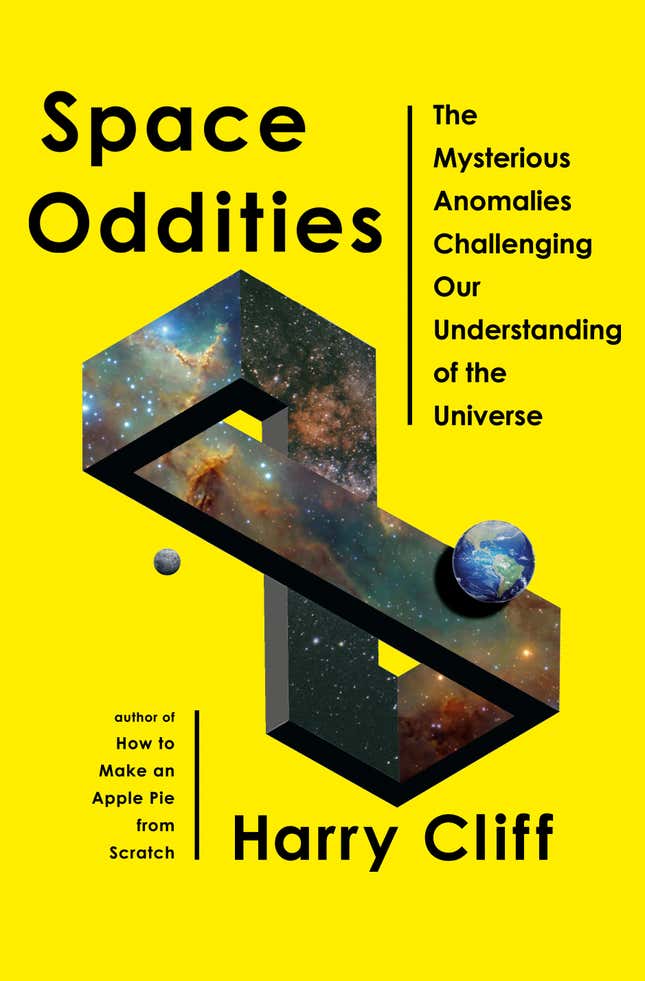The universe is a deeply vexing place. Each breakthrough we make in our understanding of it begets extra mysteries about how all this (gestures wildly) truly occurred. Within the new e-book Space Oddities: The Mysterious Anomalies Challenging Our Understanding of the Universe, experimental physicist Harry Cliff describes a handful of probably the most confounding phenomena at play in physics. Cliff charts the trail that scientists have taken to reach at our trendy understanding of the way it all works.
From lots so small they operate extra like waves to the black holes that disguise their interior workings with distinctive success, Cliff covers probably the most enigmatic phenomenon identified to people. He additionally introduces the extraordinary individuals in search of to interrupt down these anomalies. Fixing even considered one of these mysteries might unlock a brand new period of scientific understanding.
Beneath is my dialog with Cliff, flippantly edited for readability.
Isaac Schultz, Gizmodo: This e-book is your second, after How to Make an Apple Pie From Scratch. Why did you determine to embark on this second challenge? What was lacking, both in your physique of labor or within the printed sphere, so far as particle physics is anxious that wanted addressing?
Harry Cliff: It actually got here out of my analysis. I work on the Massive Hadron Collider. I got here in proper originally of the Massive Hadron Collider, on the finish of the primary decade of the twenty first century. And I’ve been there ever since. Mainly what occurred is we found the Higgs boson, which is nice and really thrilling, and that form of rounded off our understanding of twentieth century physics in some sense. The nice hope was there can be new discoveries of issues that we didn’t learn about earlier than, like darkish matter or supersymmetry or no matter, and none of that appeared. All these expectations have been kind of not realized. However all through high-energy physics, we have been seeing these anomalies, which have been hinting on the potential existence of latest particles or new forces that we hadn’t imagined. That was actually, actually thrilling.
My very own analysis from about 2015 onwards actually centered on these anomalies. It’s an attention-grabbing thought that individuals could also be not so aware of, as a result of within the historical past of physics and our understanding of nature, the most important breakthroughs typically do come from these little bizarre niggling results that you simply would possibly dismiss at first, that nobody actually understands. They change into some clue to some huge new shift in the way you see the world.
The e-book is actually an try and each discover what’s happening in analysis, in cosmology and our understanding of the universe in the mean time, but additionally set this in some form of context and say, “the rationale these items are so thrilling is as a result of up to now, they’ve led to those actually huge breakthroughs, and have a look at the place this may be taking us sooner or later.”

Gizmodo: I communicate rather a lot with of us who’re in search of indicators of darkish matter. It looks like a lot of the work proper now’s simply narrowing the mass vary. It’s received to be on the market. Or a minimum of we count on it to be. However the excellent query is, “when will this occur?” The general public and clearly the media would love for it to be an enormous “newsflash!” expertise. However one factor that you simply contact on within the e-book is that science, as a rule, doesn’t work that manner.
Cliff: Often these items emerge steadily. You get your first clues, and typically it takes a long time or extra to unravel these items. One of many examples within the e-book is that this bizarre drawback with the orbit of Mercury that was noticed within the nineteenth century, the place Mercury’s turning up too early, mainly, for transits of the Solar. That took a few century extra to determine what was a reason behind it.
It’s fairly uncommon in science that there’s this ‘eureka!’ second the place every thing turns into clear. That occurs extra typically while you’re discovering one thing you count on to see. The Higgs boson was an instance of that. It had been predicted 50 years earlier; you construct a Massive Hadron Collider to experiment, see this new bump in a graph, however they know what it’s, as a result of they’re anticipating it. You possibly can say: On the 4th of July 2012, the Higgs was found. While you’re actually discovering one thing new that’s outdoors your expectation, it takes rather a lot longer, since you’ve received to persuade your self of what you’re seeing, you’ve received to persuade others of what you’re seeing. Individuals are rather more prepared to simply accept issues they anticipated and rather more resistant to simply accept issues they didn’t see coming.
One of many tales within the e-book is about Adam Riess, the Nobel Prize-winning cosmologist. He’s been coping with this drawback with the growth of the universe. He’s been slogging at this now for a decade, and from his standpoint, this anomaly is like gold-plated. They’ve checked each potential impact, and it appears that evidently there actually is that this anomaly there. However as a result of there isn’t a ready-made theoretical clarification for what’s inflicting this, the remainder of the sphere is rather more skeptical. He’s received an actual job on his arms of persuading his colleagues that that is the true deal.
Gizmodo: You open and shut the e-book with the Hubble rigidity. Why? What makes that the pivot level?
Cliff: It’s partly as a result of house is simply sexier than particle physics. I feel it’s simpler for individuals to interact with one thing that’s happening out in house, and stuff that’s happening on the subnuclear degree is just a little bit extra summary and onerous to get your head round. It’s fairly romantic to be fascinated with galaxies and the growth the universe. I take care of 5 huge anomalies within the e-book. There’s 5 substantial chapters on stuff that’s happening in the mean time.
I consider all of them, the Hubble rigidity is the one which I personally discover probably the most compelling, simply because it’s the one the place idea may be very clear about what ought to occur, and the experimental proof appears very sturdy. It’s not simply Adam Riess’ group. There are many teams. Each measurement, mainly, that has been product of the growth of house utilizing stuff within the native universe—and by native we’re speaking, you realize, big distances nonetheless, however galaxies and stuff you could see—all of them mainly line up, kind of. There’s a number of that kind of wobble about, nevertheless it appears not possible at this stage, after a decade of scrutiny, that there’s some actually huge mistake that has been missed. There’s one thing to be understood, for certain. Now, whether or not that’s one thing that’s really revolutionary, like a rewriting of the legal guidelines of gravity or a brand new type of vitality within the universe that we haven’t understood earlier than, possibly telling us one thing about darkish vitality. It might be one thing to do with the assumptions that we’ve got in cosmology about the concept the universe appears the identical in each route, and that the place we’re within the universe isn’t significantly particular. It’s the kind of assumption that we make so as to have the ability to do cosmology. I feel that it’s the anomaly that’s most likely telling us one thing fairly profound. The opposite 4, I feel, are rather more tough to say what’s happening.
In case you take 100 anomalies—and anomalies come and go in physics on a regular basis—most of them will go away. It’d solely be considered one of them that truly seems to be the true clue. The explanation I picked these explicit 5 is as a result of they’re ones which were round for fairly a very long time. We are going to be taught one thing essential within the strategy of unraveling these ones, however I feel they’re much less more likely to flip into some huge new physics discovery. Whereas I feel the Hubble rigidity, of any of them, goes to do it. That’s the one I’d put my cash on.
Gizmodo: How did you select the experiments that you’d spotlight and the interviews that you’d do with physicists, to liven up every of those mysteries?
Cliff: The very first little bit of the prologue is an outline of an experiment referred to as ANITA, which is an unimaginable experiment. It’s mainly an enormous radio antenna launched into the Antarctic skies on this large helium balloon. A part of the rationale for selecting that story, together with the anomaly being very attention-grabbing, is simply the experiment is actually cool. At first of writing, I used to be considering, how might I get a manner of wrangling a visit to Antarctica out of this? However I simply realized that was not going sensible or inexpensive. So I needed to form of go secondhand. However a few of the main individuals concerned are in London, which is the place I’m primarily based. In order that was a form of straightforward first win.
However I did do plenty of touring to the States and different locations to see individuals for the opposite anomalies. I used to be actually led extra by the anomalies themselves and fewer by the experiments. However considered one of them is about my very own analysis and concerning the LHCb experiment at CERN. That’s an surroundings I do know very nicely. So I might describe that firsthand, whereas the others, say, Fermilab, I went there. One of many privileges, I suppose, of engaged on these kinds of books is you ship emails off to individuals and say, “can I come to your under-mountain lair the place you do your darkish matter experiment?” And individuals are very open. “Oh yeah, certain. Come alongside and we’ll present you round.”
Loads of the environments that particle physics and astronomy experiments are carried out are actually fairly extraordinary locations. An essential a part of getting throughout the science isn’t just the ideas and the phenomena that being studied, however these extraordinary environments the place the scientific analysis is carried out.
Gizmodo: I typically take into consideration physics in two methods, “wanting up” and “wanting down” science. Particle analysis deep underground, that may be a “wanting down” experiment. Trying on the Hubble fixed, learning the Cepheid stars, can be wanting up. Within the e-book, you say we dwell in a universe of fields greater than a universe of particles, however we give attention to particles as a result of they’ve mass. How did you strike a stability of the “wanting up” science and the “wanting down” science, so to talk?
Cliff: We mainly have two methods of learning the universe. One is by, as you say, wanting up, and the opposite is by wanting in. I say, possibly not wanting down a lot, however wanting inwards. You possibly can glean a certain quantity of data from wanting on the heavens, however the limiting issue is a lot of the universe is inconveniently distant and you’ll’t go. We’ve solely been so far as the Moon by way of human exploration. When it comes to machines, out to the sides of the photo voltaic system now, with Voyager. However that’s a tiny, tiny fraction of the scale of the universe.
It’s actually by means of the mix of those two methods that we’ve managed to make a lot progress. Probably the most revolutionary discoveries, and possibly not appreciated in these occasions outdoors of astrophysics, was the invention of spectroscopy. The invention that atoms of explicit parts emit these attribute wavelengths of sunshine and soak up them. That was absolutely the key to unlocking a lot concerning the universe. That discovery was made by utilizing parts that we’ve got on Earth, after which permits us to say what the Solar is made out of for the primary time, or what probably the most distant star is made out of. So by bringing these two issues collectively, finally that’s how physics makes progress. They’re actually simply two other ways of wanting on the identical phenomena. And by bringing these two concepts collectively, that’s the way you get a full image.
Gizmodo: The high-luminosity Large Hadron Collider is on the horizon. Are you significantly excited for this subsequent era LHC? What do you assume would possibly come of this?
Cliff: It’s going to be actually attention-grabbing. We’ve solely analyzed a tiny fraction of the information that’s finally going to be recorded by the high-luminosity LHC. In a manner, this experiment has turn into much more essential, as a result of what we’ve got discovered within the final decade or so is that if there may be new physics on the vitality scales that we’re probing on the LHC, it’s hiding fairly successfully. A high-precision machine the place you get, you realize, orders of magnitude extra information will permit us to eke out if there are these very uncommon occasions, uncommon processes which might be hiding within the information. That’s going to be our greatest probability of seeing them.
However the different factor I feel plenty of colleagues at the moment are emphasizing is what the legacy of the LHC goes to be. Even when we don’t uncover any new physics on the LHC, it’s going to depart this extraordinary legacy of the understanding the fundamental components of our universe and the legal guidelines that govern their conduct. The essential purpose by the tip of the 2030s, when this factor powers down for the final time, is that we are going to have actually lovely, exact measurements of the Normal Mannequin. That’s going to be actually essential, as a result of after we go to the subsequent experiment, no matter that could be, it’s that form of groundwork that we’ve carried out that can permit us to see when ultimately the brand new factor crops up. However after all, we could also be fortunate, and we could get the brand new factor within the coming 12 months.
Gizmodo: You’ve gotten a few anecdotes within the e-book about Fall of Icarus-esque errors, the place complete experiments have collapsed as a result of misunderstanding of the numbers or taking the numbers from the flawed locations. It connects with what you wrote about Fermilab’s muon G-2 experiment, the place it pays to double-blind your self from your personal experiments. In any other case the numbers are tantalizing in a manner.
Cliff: Yeah, completely. One of many quotes that I really like that I put within the e-book is from Feynman, which is that “the primary rule is you have to not idiot your self, and you’re the best particular person to idiot.” Individuals are in science as a result of they wish to make discoveries. The temptation to consider while you see some impact in your experiment is large, as a result of everybody needs that pleasure, that second of seeing one thing that nobody has ever seen earlier than. I feel an important high quality for experimental physicists is skepticism, and actual warning. Typically even very, very cautious and skeptical individuals make errors. That will not be as a result of they’ve, you realize, massaged the information or carried out something flawed. It’s simply that there’s some very refined impact that no one considered.
And that does occur. In my very own space of analysis, we had a sequence of anomalies that ultimately turned out to be some very refined backgrounds that we thought we had beneath management. However after we by probability stumbled upon some proof that these items have been truly not beneath management, we ultimately untangled this. In different instances, it’s idea that may go flawed. Incorrect assumptions can creep in. And even typically actually fundamental, like highschool errors the place you unintentionally put a -1 as a substitute of a +1 or one thing. That really did occur within the muon experiment you have been referring to. There actually was an indication error in a calculation that made individuals assume they have been seeing proof of latest physics.
However then there are examples the place individuals take shortcuts. That comes typically from this fierce need to be first. And for those who’re in competitors with one other experiment, you wish to be the one which makes the massive discovery. And that’s the place the temptation to not do one thing utterly rigorously can are available in, and that may be fairly disastrous for those who then make some huge declare that seems to not be right. However that’s the wonderful thing about science. It’s self-correcting. And even when one thing will get printed that seems to be flawed, it can get discovered virtually at all times, ultimately.
Gizmodo: An instance of that form of scientific hubris is the Mercury-Vulcan difficulty the place, as you describe within the e-book, this prestigious astrophysicist barges into an newbie astronomer’s dwelling, and unexpectedly launches this inaccurate discovery. As you say, it takes a century of undoing, nevertheless it will get carried out.
Cliff: That was a loopy one, as a result of the discoverer of this non-existent planet received, like, France’s highest honor, for locating one thing that didn’t exist.
Gizmodo: There’s that occasion and one other second you describe, the place a younger Richard Feynman may be very nervous about giving a speech in entrance of Paul Dirac.
Cliff: One of many causes for bringing within the historical past is to set the trendy experiments in context. They’re a part of a protracted course of that stretches again a long time typically, of experimentation, theorization. You’re form of constructing all of this amassed data after which taking the subsequent step that possibly results in one thing thrilling.
Gizmodo: You have been doing a lot touring, talking to of us in numerous fields of physics than your personal for the e-book. What did you be taught that was new to you?
Cliff: I suppose the factor I actually got here away appreciating is simply the trouble that goes into, significantly, the experiments. You’ve gotten individuals dedicating a long time of their life to measuring one quantity. Take the muon G-2 experiment in Fermilab for instance. Chris Polly, who’s the spokesperson of the experiment, who confirmed me round Fermilab, he’s been engaged on this one quantity his complete profession. He did his PhD on the primary model of the experiment. His colleagues led the event of this new model, which concerned this large logistics challenge of transferring this magnetic ring from New York to Chicago through the Atlantic and the Mississippi River, after which years and years and years of painstaking work, understanding each little little bit of the experiment, measuring the magnetic fields to loopy precision, controlling the surroundings throughout the warehouse. And it’s solely in any case of this unimaginable care that lastly, on the finish of that course of, you get a quantity. And that’s the factor you’re aiming for. I’ve received big admiration for individuals like that who’re prepared to undergo a long time of slog to truly add just a little bit of latest data to the financial institution of our understanding about nature.
Gizmodo: Are you able to inform me a bit about your work on the LHCb experiment?
Cliff: LHCb is among the 4 huge experiments on the Massive Hadron Collider, this 27 kilometer ring the place we collide particles. The B stands for magnificence, which is the identify of one of many six quarks in nature, additionally extra normally often called a backside quark. However we’d reasonably be often called magnificence physicists than backside physicists. Mainly, when it was found, there was this sort of toss-up about what it was going to be referred to as. Most individuals name it backside; we name it magnificence.
The explanation these items are attention-grabbing is that the way in which they behave, the way in which they decay, may be very delicate to the existence of latest forces or new particles that we’ve not seen earlier than. So these are an ideal laboratory for looking for oblique proof of one thing that we’ve not seen earlier than. It’s a praise to the opposite experiments on the LHC, the place you bash stuff collectively and also you attempt to create new particles. So that you would possibly search for a Higgs boson or darkish matter or no matter. At LHCb it’s a special sport, of precision, of measurement, and primarily making an attempt to eke out one other decimal place the place you would possibly begin to see a deviation. That’s the form of physics that we do. I’ve been on LHCb because the begin of my physics profession now. So, since 2008, and we’re nonetheless going sturdy. We’ve simply had an enormous improve, and the experiment is taking information at an growing fee. So we’re hopefully going to get extra details about these anomalies within the subsequent 12 months or two. It’s an thrilling time.
Gizmodo: What was it like writing the e-book alongside the work you have been doing on the LHC?
Cliff: After I began writing the e-book, the anomalies that we have been seeing on the Massive Hadron Collider have been wanting actually, actually compelling and thrilling, and there have been fairly a number of outcomes that got here out that received plenty of media consideration. There was this actual sense that we have been getting ready to one thing very thrilling. After which, as I used to be writing the e-book on the identical time, we have been realizing that there was one thing that we’d missed. So it was form of a salutary expertise as a scientist, going by means of that strategy of considering you’re getting ready to one thing after which realizing—to your horror—that there’s a bug, primarily, in evaluation. I didn’t wish to draw back from that within the e-book.
I wished to offer a way of what science is definitely like. And while you’re working on the limits of understanding, you’re actually taking dangers. You might be in actual hazard of creating errors since you don’t know what you’re doing. You’re doing the perfect you may, however you’re on unexplored terrain, and there’s a really excessive danger of creating errors. My skepticism, most likely my youthful enthusiasm, could have given option to a barely extra middle-age skepticism on account of this entire expertise, which I hope will make me a greater scientist in the long term.
Trending Merchandise

Cooler Master MasterBox Q300L Micro-ATX Tower with Magnetic Design Dust Filter, Transparent Acrylic Side Panel…

ASUS TUF Gaming GT301 ZAKU II Edition ATX mid-Tower Compact case with Tempered Glass Side Panel, Honeycomb Front Panel…

ASUS TUF Gaming GT501 Mid-Tower Computer Case for up to EATX Motherboards with USB 3.0 Front Panel Cases GT501/GRY/WITH…

be quiet! Pure Base 500DX Black, Mid Tower ATX case, ARGB, 3 pre-installed Pure Wings 2, BGW37, tempered glass window

ASUS ROG Strix Helios GX601 White Edition RGB Mid-Tower Computer Case for ATX/EATX Motherboards with tempered glass…










